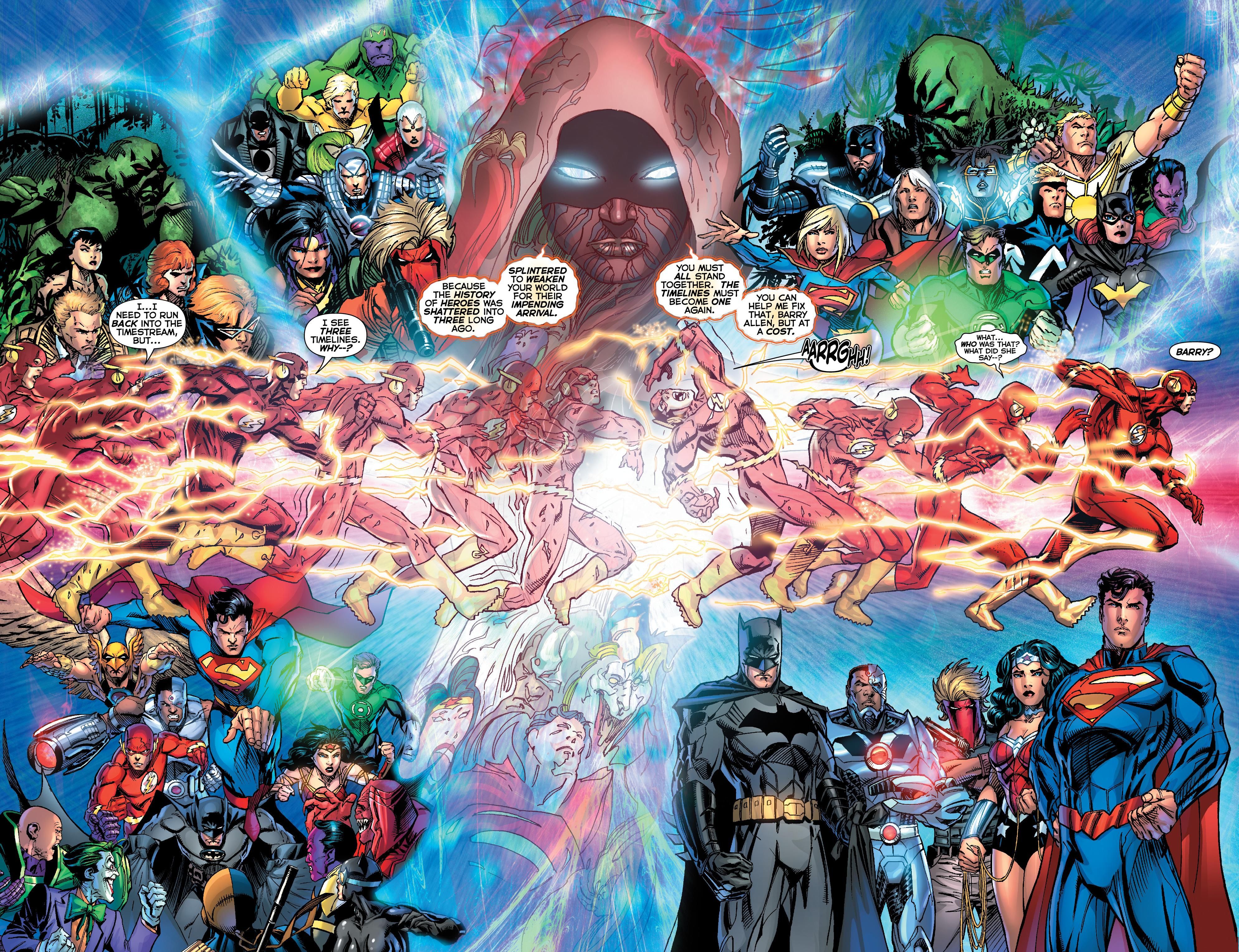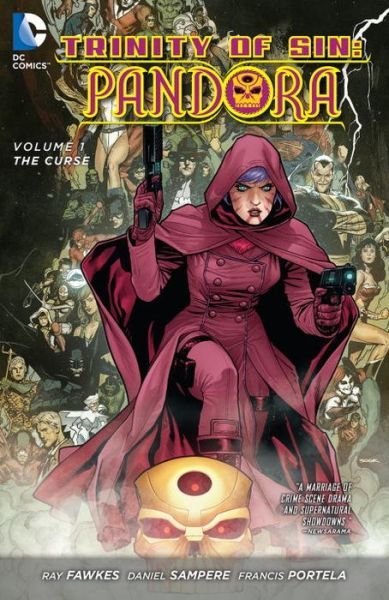In summer 2011, the Geoff Johns/Andy Kubert event series Flashpoint was reaching its climax, and the fifth issue was devoted to The Flash trying to unscramble the mixed-up, dystopian timeline in a typically Flash way -- by running around really fast.
Near the end, there was a strange, two-page spread of an interlude that seemed almost grafted on: The Flash catches a glimpse of a mysterious, hooded woman with glowing eyes and lines all over her face, who says portentously, "Because the history of heroes was shattered into three long ago. Splintered to weaken your world for their impending arrival. You must all stand together. The timelines must become one again."
The timelines were those of the DC Universe, the WildStorm Universe and a handful of DCU characters who had mainly been appearing in books published by DC's Vertigo imprint. The result? The New 52, the biggest and most dramatic reboot the oft-rebooted, retconned and otherwise tinkered-with DC Universe had ever experienced in the history of forever; they even relaunched Action Comics and Detective Comics!
So big a deal was the mysterious lady that she appeared in the first issue of every single one of the 52 new titles. She starred in the publisher's first Free Comic Book Day offering after the reboot. She played a role in the three-book "Trinity War" crossover story, which one might reasonably have assumed to have something to do with the three timelines she merged in order to combat a threat of some kind (Although it didn't). When she finally got her own series, Trinity of Sin: Pandora, the cover of the first issue was filled with pretty much every character in the updated catalog.
This lady was obviously important, and her story would be central to the understanding the new status quo of the DC Universe, right?
Unfortunately, DC has yet to follow up on the mysterious, in-story reasoning for the biggest change to its fictional setting and superhero line since Crisis on Infinite Earths (if not longer), and nothing underscores and emphasizes the publisher's rather perplexing decision to build up the character and her conflicts and then ignore them like a reading of Trinity of Sin: Pandora #1: The Curse, the new trade collection of the first five issues of the series, plus the aforementioned FCBD title.
The lady in the hood gradually grew more defined, with the lines on her face eventually becoming Rachel Grey-like tattoos, only more lightning-bolt in shape. The hood became more red than purple, and part of a rather smart suit. And, of course, she got a name: Pandora, from the figure in Greek mythology who released all of the misery and evil into the world.
The trade opens with material from the FCBD special and Justice League; that passage is written by Geoff Johns and drawn by five different artists. In it, we see The Phantom Stranger arguing with Pandora about the whole merging of the timelines thing. "You rewrote reality," he says. "I realigned it. I strengthened it," she says. "You think you did. You're dangerous," he says.
We then learn their origins. Along with a third person who would turn out to be The Question, Pandora and The Stranger were summoned to The Rock of Eternity, where a council of magical people from different cultures, but all wearing some article of clothing decorated with a Captain Marvel logo-like lightning bolt, sit in judgment of them.
"You three are the greatest transgressors mankind has ever known," one of them says, "You three are THE TRINITY OF SIN." Pandora, The Stranger and The Question were then sentenced to immortality and various other curses, released to walk the world for an eternity contemplating what they've done wrong.
But Pandora's main interest isn't in ... whatever's up with all these magic people. She merely wants to recover Pandora's Box— in the DCU, a shiny golden, three-eyed skull — and put the things that escaped from it back in (here, the Seven Deadly Sins ... the same ones that the Wizard Shazam kept imprisoned as statues on the Rock of Eternity in the old DCU).
And then we get to the first issue of Pandora proper, where the series' regular writer Ray Fawkes takes over, joined by primary artist Francis Portela (with meet-the-deadline contributions by Daniel Samper).
Fawkes splits his time for the first three issues revealing Pandora's origins and the centuries she spent learning how to combat and one day kill the Seven Deadly Sins (meanwhile, flashing back to scenes readers of the trade will have seen mere pages ago), and focusing on her involvement in the Justice League/Justice League of America/Justice League Dark crossover story "Trinity War," which is essentially a bunch of different players trying to get their hands on Pandora's Box.
Turns out it is actually just a Mother Box to Earth-3, a parallel universe where the Crime Syndicate, the evil opposite Justice League, hails from. The Sins aren't the cause of sin on Earth, just interdimensional parasites who fed on the preexisting sin of Earth-New 52. Everything Pandora thought she knew – for, like, three issues — turns out to be wrong! (And, incidentally, the "Trinity" in "Trinity War" had nothing to do with the heroic Trinity of Superman, Batman and Wonder Woman, or the "Trinity of Sin," or the three timelines that Pandora somehow — it's yet to be explained how or why — used to forge The New 52 continuity.)
After three issues of "Trinity War" tie-ins, and their dismantling of the presumed premise of the series, the Pandora monthly is then surrendered to Forever Evil tie-ins ... and that's where the trade ends.
This week Trinity of Sin: Pandora #9 also shipped, but you'll find that the latest issue still has Pandora involved in Forever Evil tie-ins (specifically, a storyline titled "Blight" that's running through a bunch of the DC books featuring magical characters that seems mainly designed to explain what John Constantine and The Phantom Stranger are doing instead of saving the world from the Crime Syndicate). There has yet to be an issue of Pandora's monthly that hasn't had the logo for either "Trinity War" or Forever Evil on the cover.
It makes for a very weird read, given the build-up the character received. The one story that pretty much anyone who was reading DC comics before and after the New 52 reboot wants to have told is being consistently, aggressively ignored ... despite the now-monthly adventures of the character who is at the center of that story.
There's still one more issue to go in the Forever Evil series, of course, but it seems highly unlikely that the threat Pandora merged the timelines together to face was the Crime Syndicate (For one thing, no one from the WildStorm Universe seems to be dealing with the Syndicate on any level in any arena; for the most part, it's just the Justice Leaguers and a handful of villains who have appeared in Forever Evil proper).
The Crime Syndicate, as anyone reading Forever Evil will know, is only on this Earth because their home one was destroyed by a vague, unnamed threat they fear is on the verge of following them here. Could that be the threat promised in Flashpoint #5? Maybe, but unlikely, for the same reason -- so far, the DCU timeline seems like it will be sufficient to the task of taking on all comers without any help from Swamp Thing or the WildCATS.
If DC is going to get around to telling the story of the New 52's formation, it will likely happen in the next big storyline. The publisher hasn't announced a follow-up to Forever Evil yet, but there's so much to get done in the one remaining issue that it seems quite likely the series will simply prove the second act of a bigger story, much like "Trinity War" ended up merely serving as a prelude to Forever Evil rather than its own story.
All of which makes the decision to launch an ongoing monthly starring the character who created The New 52 without actually telling or even teasing that story so perplexing. Based on this volume, it seems like the publisher has so far changed its minds at least twice about who Pandora is and what her deal is, and that her book is one devoted to treading water.


